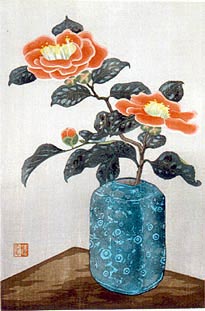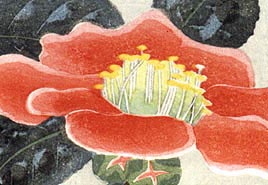

URUSHIBARA Mokuchû (1888-1953)
In his early years at the British Museum, Urushibara worked as a free lance mounter and restorer of paintings and scrolls. Through his carving and print designs he exerted an important influence on the revival of color woodblock printmaking in England in the 1920s-1930s. His collaboration in 1919 with the Belgian-born and British-trained graphic artist and muralist Frank Brangwyn (1867-1956) was perhaps Urushibara's most well-known project, for which he reproduced Brangwyn's watercolors as large woodblock prints in a portfolio titled "Bruges." The two artists collaborated a second time in 1924 by issuing a set of ten small prints for the portfolio "Ten Woodcuts by Yoshijirô Urushibara after Designs by Frank Brangwyn." During the 1910s-1930s Urushibara also designed and printed his own woodblock prints, including scenes of landscapes, flowers, and horses.
Urushibara's printing technique is subtle and refined with pale shades of gray worked into the main color areas of red (two shades), green (four shades), and blue (two shades). He used keyblock outlines only in selected areas of the design; otherwise, the colors were applied without outline and allowed to flow slightly for a soft edge effect (see detail above left). Color gradations were also used effectively to give depth and texture to the camellias. It is easy to see why Urushibara's skills were so much in demand in London for roughly thirty years and why English artists would have become interested in exploring the possibilities of color woodblock printing for their own designs. ©1999-2019 by John Fiorillo BIBLIOGRAPHY
|
Viewing Japanese Prints |

 The image on the right is a print issued circa 1930s depicting red camellias in a blue vase. It is an aiban-size print on
paper measuring 346 x 237 mm, signed in pencil "Y. Urushibara" in the lower margin and sealed on the lower left of the image. (In contrast to the example above with its light-gray background, impressions are known with a black background.)
The image on the right is a print issued circa 1930s depicting red camellias in a blue vase. It is an aiban-size print on
paper measuring 346 x 237 mm, signed in pencil "Y. Urushibara" in the lower margin and sealed on the lower left of the image. (In contrast to the example above with its light-gray background, impressions are known with a black background.)